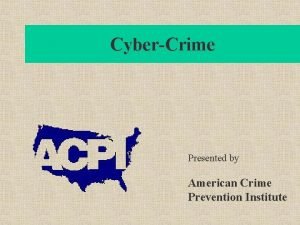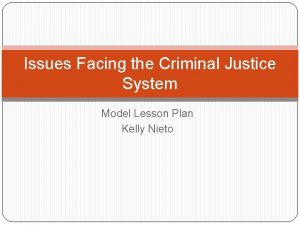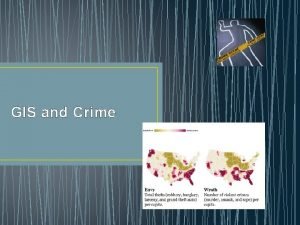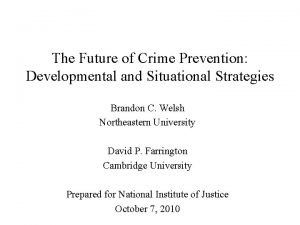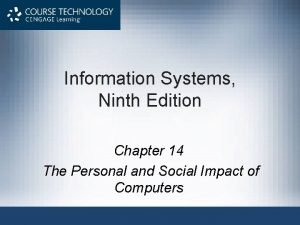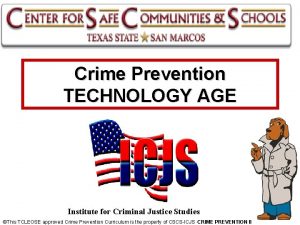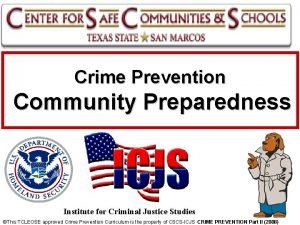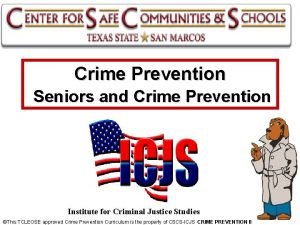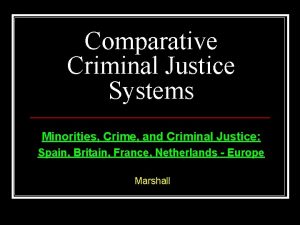Crime and Prevention TRENDS Institute for Criminal Justice





























































- Slides: 61

Crime and Prevention TRENDS Institute for Criminal Justice Studies ©This TCLEOSE approved Crime Prevention Curriculum is the property of CSCS-ICJS CRIME PREVENTION II

Objectives • Consider current trends in crime and prevention • Explore five major, emerging trends and challenges over the next 20 years • Examine ways to meet these challenges • How to use crime prevention as a strong foundation • Ways to move forward

Why Pay Attention to Trends? • Trends change our lives. • A line of general direction or movement, current style or prevailing tendency or inclination.

In 1986 How would you: • How would you have called for emergency road service? • Today? • How could you get cash out of your bank in a strange city at 1: 00 am? • Today?

In 1986 How would you: Continued • How big was a high-quality personal music player? • Today? • How bulky were televisions? • Today?

Crime Prevention Implications • Some crime prevention implications: ØCell phones: ØATM: ØLightweight TVS: ØI-pods:

Other Recent Trends • On-line banking • Cyberbullying • Identity theft • Local terrorism

Understanding Crime Trends Helps Us… • Anticipate prevention needs • Learn from the past • Reap the benefits • Serve as effective advocates

Where Are We Now? • Geography no longer governs community. The physical neighborhood around one’s residence is only part of community. • People now operate in many different communities that overlap only slightly if at all.

Here are some of these Communities • Work • Home • Extended family • Shopping • Recreation

Here are some of these Communities – continued: • Faith • Professional associations • Special interests (hobbies, civic, fraternal, etc. )

Crime Trends and How We Count Crime Counting crime helps us track our progress. At the national level, there are currently two systems. • National Crime Victimization Survey • FBI Uniform Crime Reports www. fbi. gov

Crime Trends and How We Count Crime (cont. ) • Two emerging systems will lead to more detailed and localized data: Ø FBI National Incident-Based Reporting System Ø Local Crime Victimization Surveys

Current Crime Trends • In 2007, U. S. residents (12 years and older) experienced 23 million violent and property crimes -- an estimated 18 million property crimes (burglary, motor vehicle theft, and theft) and 5. 2 million violent crimes (rape, robbery, aggravated and simple assault, and homicide).

Current Crime Trends (cont. ) ■ Personal and household victimizations are at 32 -year lows, according to 2007 National Crime Victimization Survey data. Source - BJS - National Crime Victimization Survey (Criminal Victimization, 2007) ■ FBI Uniform Crime Report data for 2007 show a 2. 4 percent increase in reported violent crime compared with 2006. Property crimes decreased by 1. 8 percent in the same period. Source: Federal Bureau of Investigation 2007

Current Crime Trends (cont. ) • In 2007, 49 percent of violent crimes and 43 percent of property crimes were reported to police, a substantial increase from the 35 percent to 40 percent reporting levels in the late 1970 s. Source – BJS, National Crime Victimization Survey (Criminal Victimization 2007)

Current Crime and Prevention Issues • Methamphetamine, identity theft, theft fraud against seniors, gangs, and homeland security are among the hot issues nationwide. • Many residents feel that serious crime occurs only in isolated areas within their communities.

Current Crime Prevention Issues (cont. ) • Computers as tools of personal and economic crime are a wellestablished fact. • Information brokering is a new criminal activity

Current Crime Prevention Issues (cont. ) • Emphasis on fact-based, fact-based researchbased programming is becoming a standard. • Pressure to demonstrate program outcomes – not how much was done but what has changed because of it – is increasingly prevalent at national, state, and local levels.

Current Crime Prevention Issues (cont. ) • Federal and state shifting of financial burdens to localities have reduce crime prevention resources. • New tools to help crime prevention

What Is the Outlook for the Future? • Five major predictions ØThe United States is significantly more diverse ØCommunications technology is evolving dramatically.

Five major predictions continued ØData technology is expanding dramatically. Ø People live longer, longer are more active longer. ØThe need to educate each new wave of children, adolescents, and adults continues.

U. S. Demographics and Diversity Predictions • The United States is becoming more diverse • Estimates are that by 2050, people of color (predominantly African Americans and Hispanics/Latinos) will comprise nearly a majority of the U. S. population.

2010 % of TOTAL White alone Black alone Asian alone All other races Hispanic (of any race) White alone (not Hispanic) 100. 0 79. 3 13. 1 4. 6 3. 0 15. 5 65. 1 THIS DOES NOT INCLUDE UNDOCUMENTED ALIENS * Includes American Indian and Alaska Native alone, Native Hawaiian and Other Pacific Islander alone, and Two or More Races Source: U. S. Census Bureau, 2004, "U. S. Interim Projections by Age, Sex, Race, and Hispanic Origin, “ www. census. gov/ipc/www/usinterimproj/>

2030 % of TOTAL White alone Black alone Asian alone All other races Hispanic (of any race) White alone (not Hispanic) 100. 0 75. 8 13. 9 6. 2 4. 1 20. 1 57. 5 THIS DOES NOT INCLUDE UNDOCUMENTED ALIENS

U. S. Demographics and Diversity Challenges • We will have more diverse languages, languages cultures, norms, issues of personal and group behaviors, and ideas of lawful behavior and activity.

U. S. Demographics and Diversity Challenges – cont’d • Laws and enforcement of the laws we have in place may conflict with the customs and experiences of diverse populations. • One size will not fit all in crime prevention.

U. S. Demographics and Diversity Recommendations • Develop ways to explain legal and enforcement systems so they can be understood by diverse populations. How could this impact adversely on Crime Prevention?

Diversity Recommendations – Cont’d • Develop crime prevention strategies to reach widely different populations in languages and frameworks that meet their needs. • Find and build bridges between law enforcement and various cultural groups.

Communications Technology Predictions • Communications • Youth of today • Technology

Communications Challenges • Communication Intentions • Links and Networks between criminals • Technology • LE Technical, legal administrative barriers

Communications Technology Recommendations • Develop strategies that help youth • Identify and teach youth, youth adults, and seniors

Data Technology Predictions • More information will be concentrated in more places. • More links will be established across information sources. • More economic resources will be electronically accessible.

Data Technology Predictions (cont. ) • Less direct personal contact in business, and finance • Technological race between criminals and law enforcement • Every computer user – home or workplace

Data Technology Challenges • Innovations will expand • Innovation • Generations

Data Technology Recommendations • Tailor approaches • Educate people • Encourage industry

Older Populations Predictions • People will live longer • Larger population of older people • People will be productive into older ages • Individual retirees

Older Populations Challenges • Older people are less likely to • Older people are more vulnerable • Many in this age group will need

Older Populations Recommendations • Develop crime prevention strategies • Develop behavioral, behavioral technological, and hardware crime prevention techniques • Because travel and activity are likely to be part of older people’s lifestyles, teach crime prevention accordingly.

Generation Gaps in Knowledge Predictions • Crime prevention differs • People frequently don’t teach • Each generation

Generation Gaps in Knowledge Challenges • It is hard to predict precisely how future trends will affect crime prevention • It is not clear

Generation Gaps in Knowledge Recommendations • We must persist • We need to • We should

Crime Prevention Tools and Benefits • The ten Principles of Crime Prevention set forth by the Crime Prevention Coalition of America – Engaging the Power of Prevention (2007) – provide guidance to everyone about how to build and sustain crime prevention programs and strategies.

The 10 Principles of Crime Prevention 1. Preventing crime is everyone's business 2. Preventing crime is more than security 3. Preventing crime is a responsibility of all levels of government and agencies of government 4. Preventing crime is linked with solving social problems 5. Preventing crime is cost-effective

10 Principles Continued… Preventing crime 6. Requires a central role in law enforcement 7. Requires an active cooperation and collaboration by all elements of the community 8. Requires education 9. Requires tailoring to local needs and conditions 10. Requires continual testing and improvement

Crime Prevention Improves The Quality of Life for Every Community

Building on Experience A look at achievements of crime prevention will help us update crime prevention strategies for the future. “We can chart our future clearly and wisely only when we know the path which has led to the present. ” - Adlai Stevenson

The 1970 s • Crime prevention is seen by the public as the responsibility of police. • The concept of citizen action to reduce crime emerges from Law Enforcement Assistance Administration-sponsored programs. • Neighborhood Watch is born

The 1980 s Major Developments • The role of youth in crime prevention • Comprehensive action-focused community planning emerges.

The 1990 s • Crime Prevention Coalition of America publishes Principles of Crime Prevention. • Violence prevention programs proliferate in response to a rise in youth crime. • The costs of crime are more thoroughly documented.

The 1990 s(cont. ) 1990 s • Comprehensive fact-based prevention approaches gain momentum. • School safety becomes a major issue.

Today, Our Base is Strong • Communities are safer than in the 1970 s. • People see themselves as having an important role in making their communities safer. • Crime prevention has a wider foundation than just law enforcement

Today, Our Base is Strong • The Coalition, NCPC, and Mc. Gruff continue to provide focus and resources. • The Bureau of Justice Assistance

Opportunities for Crime Prevention in the 21 st Century • Build worldwide links to strengthen prevention. • Make new communications technology effective in teaching crime prevention.

Opportunities for Crime Prevention in the 21 st Century – Cont’d • Incorporate prevention in new technologies. • Enlist new generation in crime prevention. • Strengthen and institutionalize crime prevention.

Hold on – just a minute!

The Future Just Changed • The future is not guaranteed. • We can predict but not promise.

• Prediction helps us think about the future, which helps us prepare for change, whatever it looks like. • The best advice is to stay alert, stay up-to-date, up-to-date stay flexible, stay committed – and stay safe!

National Crime Prevention Council 1000 Connecticut Avenue, NW Thirteenth Floor Washington, DC 20036 -5325 202 -466 -6272 www. ncpc. org

TEAM PRACTICAL EXCERCISE • TEAM I – Crime Prevention Implications, Other recent trends, understanding crime trends and where we are now. • TEAM II – Crime trends and how we count crime, current crime trends, current crime prevention issues. • TEAM III – What is out look for the future, US demographics and diversity predictions, demographics and diversity challenges, and recommendations. • TEAM IV – Communications technology predictions, communications challenges, communication technology recommendations. Data technology predictions, challenges and recommendations. • TEAM V – Older population predictions, challenges, recommendations, Generation gaps in knowledge predictions, challenges and recommendations.

Presenter Contact Information 350 N. Guadalupe, Suite 140, PMB 164 San Marcos, Texas 78666. 877 -304 -2727 www. cscs. txstate. edu
 Primary prevention secondary prevention tertiary prevention
Primary prevention secondary prevention tertiary prevention American crime prevention institute
American crime prevention institute Guelph cjpp
Guelph cjpp Define corrections in criminal justice
Define corrections in criminal justice Chapter 11 basic concepts street law
Chapter 11 basic concepts street law What are the branches of criminal justice system
What are the branches of criminal justice system Pornography laws connecticut
Pornography laws connecticut The criminal justice funnel
The criminal justice funnel Grass eater vs meat eater police
Grass eater vs meat eater police Eighth amendment excessive bail
Eighth amendment excessive bail Consensus model criminal justice
Consensus model criminal justice Consensus model criminal justice
Consensus model criminal justice 4 pillars of criminal justice system
4 pillars of criminal justice system Consensus model criminal justice
Consensus model criminal justice Typologies of crime
Typologies of crime Individual rights
Individual rights Consensus model criminal justice
Consensus model criminal justice Consensus model criminal justice
Consensus model criminal justice Nonintervention perspective of criminal justice
Nonintervention perspective of criminal justice Wedding cake model of criminal justice
Wedding cake model of criminal justice Arizona criminal justice information system
Arizona criminal justice information system Responsibilities of saps in the criminal justice system
Responsibilities of saps in the criminal justice system Department of criminal justice services ny
Department of criminal justice services ny National archive of criminal justice data
National archive of criminal justice data Criminal justice the essentials 5th edition
Criminal justice the essentials 5th edition Criminal justice
Criminal justice Types of intermediate sanctions criminal justice
Types of intermediate sanctions criminal justice Conflict theory criminal justice
Conflict theory criminal justice Data analysis in criminal justice
Data analysis in criminal justice The american system of criminal justice 16th edition
The american system of criminal justice 16th edition Mexico criminal justice system
Mexico criminal justice system Public health internships ct
Public health internships ct Inaccurate observation in criminal justice
Inaccurate observation in criminal justice Ocjs grants
Ocjs grants Daisy breneman jmu
Daisy breneman jmu Everyday ethics for the criminal justice professional
Everyday ethics for the criminal justice professional Management in criminal justice organizations
Management in criminal justice organizations Moorpark murder suicide
Moorpark murder suicide Task 1 match the words
Task 1 match the words Target hardening measures
Target hardening measures Crimegis
Crimegis National crime prevention council cyberbullying
National crime prevention council cyberbullying Situational crime prevention definition
Situational crime prevention definition Ron clarke 1992
Ron clarke 1992 Youth crime prevention desk
Youth crime prevention desk Developmental crime prevention
Developmental crime prevention 25 situational crime prevention techniques
25 situational crime prevention techniques Malaysia crime prevention foundation
Malaysia crime prevention foundation Crime prevention 9th edition
Crime prevention 9th edition Cyber crime prevention luxembourg
Cyber crime prevention luxembourg Formuö
Formuö Typiska drag för en novell
Typiska drag för en novell Tack för att ni lyssnade bild
Tack för att ni lyssnade bild Vad står k.r.å.k.a.n för
Vad står k.r.å.k.a.n för Varför kallas perioden 1918-1939 för mellankrigstiden?
Varför kallas perioden 1918-1939 för mellankrigstiden? En lathund för arbete med kontinuitetshantering
En lathund för arbete med kontinuitetshantering Underlag för särskild löneskatt på pensionskostnader
Underlag för särskild löneskatt på pensionskostnader Vilotidsbok
Vilotidsbok Sura för anatom
Sura för anatom Förklara densitet för barn
Förklara densitet för barn Datorkunskap för nybörjare
Datorkunskap för nybörjare Tack för att ni lyssnade bild
Tack för att ni lyssnade bild

